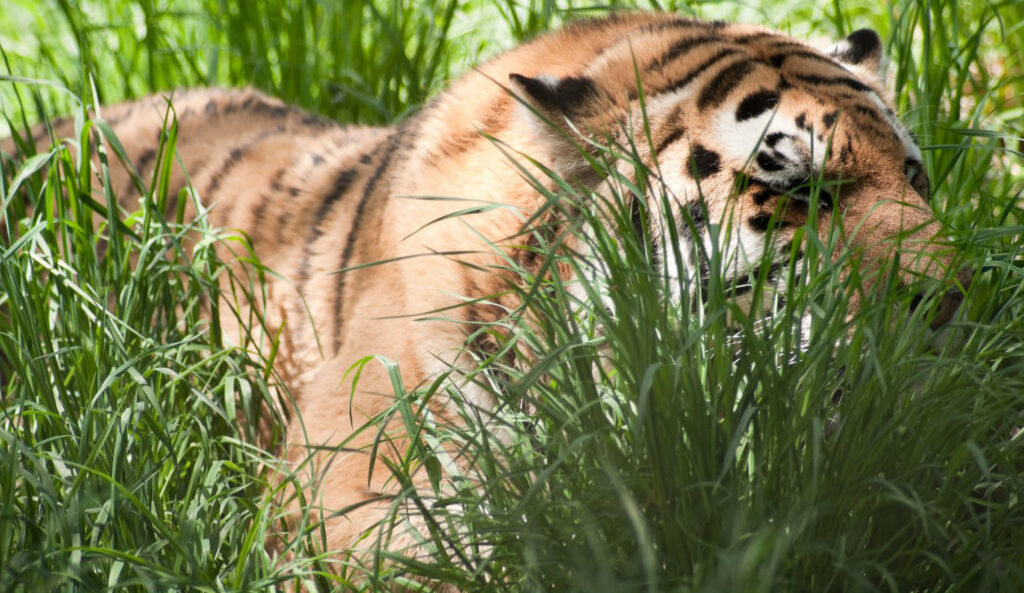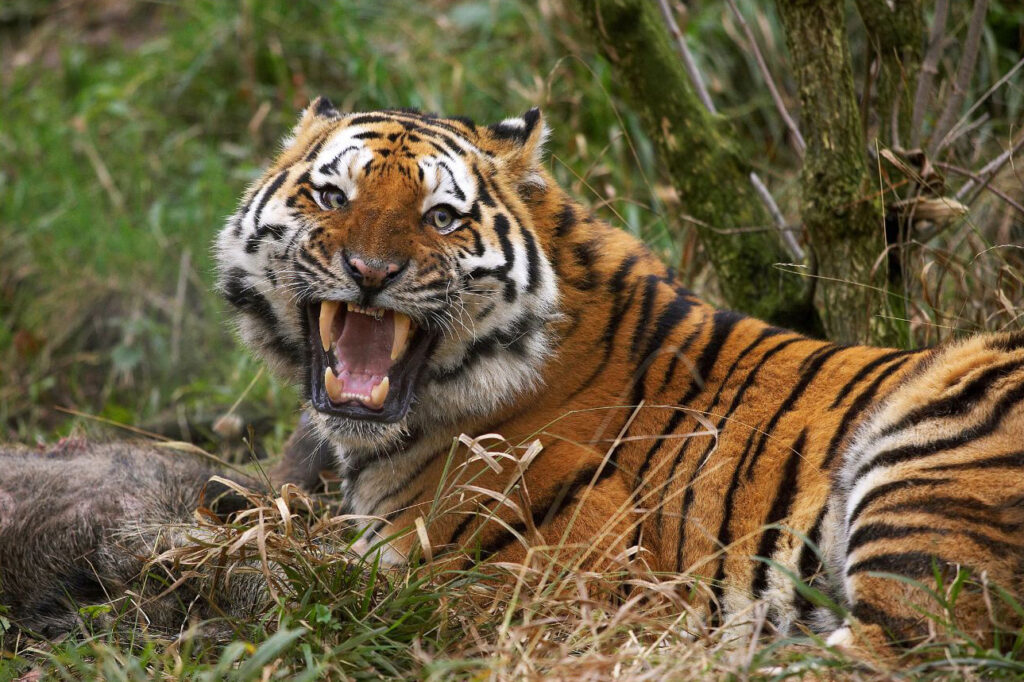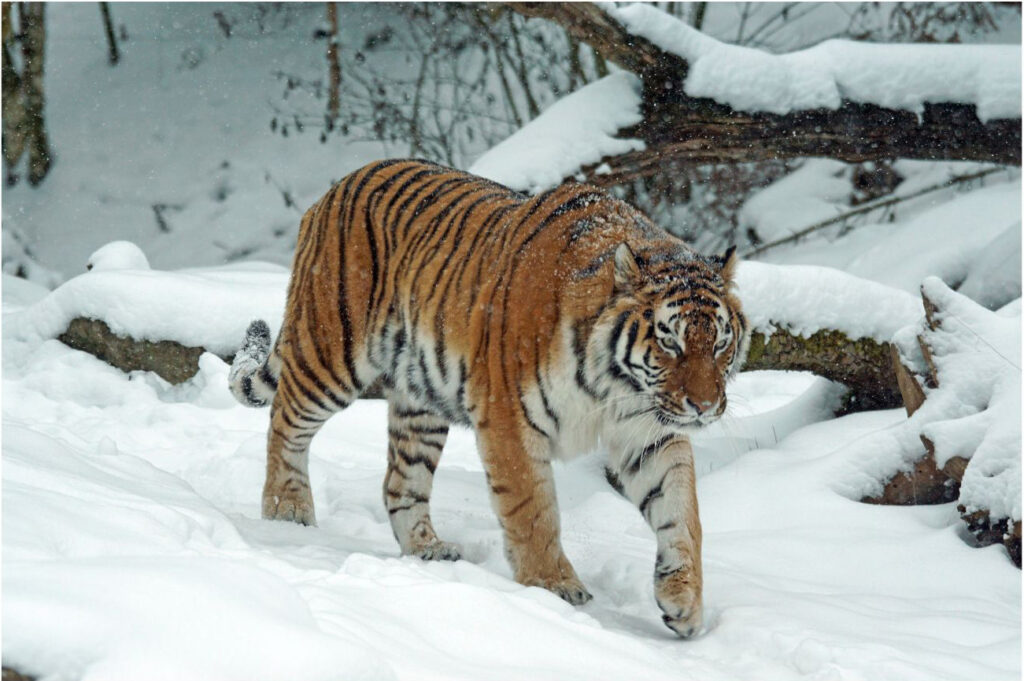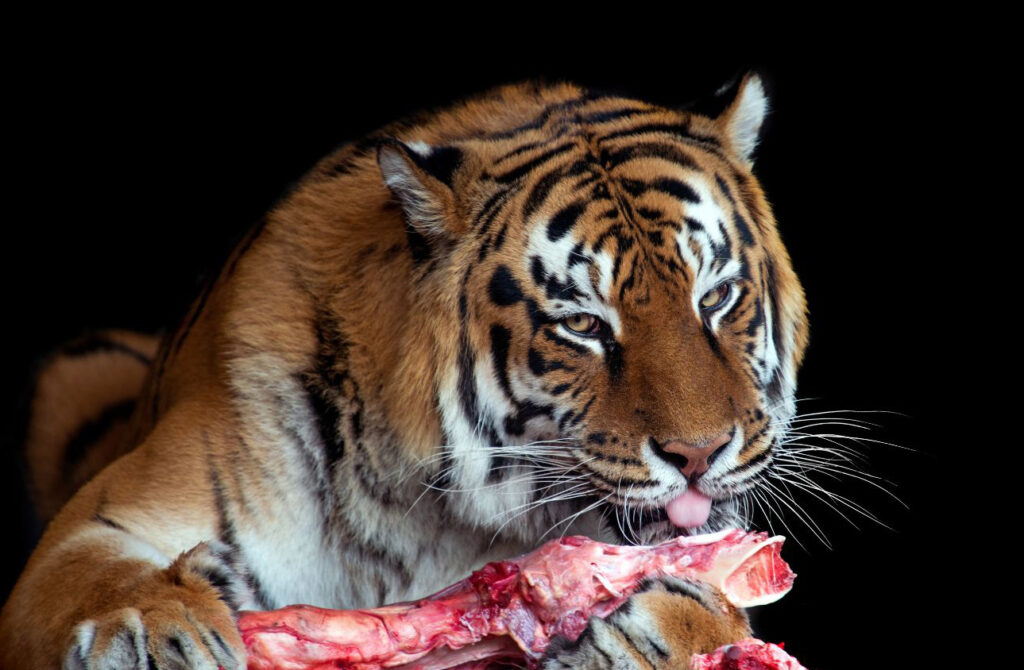Tigers are carnivores and a carnivore’s basic diet consists of raw meat. Their dentition (teeth) and digestive system are developed to process animal proteins and not plant matter.
Understanding the Tiger’s Diet
Tigers, as nature’s carnivores, primarily thrive on raw meat. Their unique teeth structure and digestive makeup are tailored for breaking down animal proteins, rendering them ill-equipped for digesting plant-based matter.

Feast Components & Routine
- Prime Proteins: Our felines feast on top-notch red meat, including equine (horsemeat) and beef, as well as premium-grade chicken and turkey.
- Chicken Necks: These aren’t just meals but also dental care tools! As natural toothbrushes, chicken necks help maintain oral hygiene, ensuring no tartar buildup. They’re packed with calcium-rich protein, and their vertebrae are safe for consumption, causing no internal harm.



Serving Proportions & Adjustments
On average, every big cat is served meat, roughly 2-4% of their body weight. However, this is a more than one-size-fits-all approach. Factors like species, weight, age, activity level, hormonal fluctuations, and other unique requirements play pivotal roles. Keeping a keen eye on the minutiae, from scat patterns to health indicators, our team ensures that the diet regimen remains dynamic and apt.
Vital Additions: To the main course, we sprinkle essential supplements. This includes bone meal for calcium and phosphorous balance, multivitamins, and probiotics to ensure robust health. A dose of glucosamine coupled with chondroitin is provided for those with joint concerns.
Natural Fasting Instinct: Taking natural cues, larger feline species like tigers and pumas undergo a weekly fasting day, especially in warmer climes. Depending on various factors, this might even extend into winter. Contrary to popular belief, these majestic creatures don’t feast daily in their natural habitats. Their digestive system functions optimally with periodic empties.



What Do Tigers Eat in the Winter?
Colder weather requires a higher calorie count for active tigers. To meet these needs, we increase their protein intake and add extra fat, which serves as both a calorie source and a vessel for oil-soluble vitamins like A, D, and E. These adjustments ensure our tigers maintain their energy and health, even during chilly weather.
Unlike wild tigers, our residents prefer prepared meals to whole prey, and for good reason—our carefully curated diets are designed to reduce risks like dental injuries or digestive issues that can come with tougher food items. Their meals are safe, nutritious, and tailored to meet their individual needs, especially for our geriatric tigers who benefit from softer, easy-to-digest food.
Tigers love winter for another reason—cooler temperatures encourage them to be more active during the day! In summer, they may prefer the shade, but in the winter, their instincts kick in, prompting them to stretch, explore, and engage in playful behaviors. This makes it one of the best times to observe their natural curiosity and energy.
To complement their diets and keep them mentally sharp, we provide winter-specific enrichment activities. These include snow mounds for pouncing, hidden treats placed strategically around their enclosures, and extra interactive husbandry sessions. These training sessions not only provide exercise but also reward them with healthy snacks while strengthening their bonds with keepers.
Our animals also enjoy heated water sources during the winter, ensuring they stay hydrated even in freezing temperatures. We take pride in providing the highest standard of care to ensure our tigers thrive in every season.
Experience Winter at Cat Tales!
Winter is one of the best times to visit Cat Tales and see our tigers at their most active. Book a tour to learn how we keep them healthy, enriched, and happy during the cold months. If you can’t visit, consider supporting their care through our Wintertime Wildlife Campaign. Your contribution directly helps us provide warm, safe, and enriching experiences for these incredible animals!
Behind-the-Scenes: Prepping these gourmet meals is no walk in the park. Our committed staff spends a hefty 4 hours daily ensuring the meals are pitch-perfect. And when it’s mealtime? Around an hour of meticulous feeding ensures that every bite is relished and safety standards are upheld.


Visitors to the Wildlife Center enjoy watching feeding time scheduled daily an hour before closing time.
Come See Our Tigers
As a rescue center our tiger population ebbs and flows with older animals, all with unique personalities and stories. We invite you to walk within 10 feet of majestic Siberian Tigers, Bengal Tigers and – if he is feeling it – Nalin, the white tiger.
Big Cat Feeding Adventures are available until just before full zoo feeding time and bring you even closer to the tigers. Private tours are the best option of all to experience these fantastic animals.
Wildlife Wonders: The Tiger’s Hunting Dance
A formidable and solitary predator, the tiger typically prefers a solo hunting expedition. It usually sets its sights on deer and antelope as its primary prey. These big cats are nocturnal hunters, utilizing the cloak of darkness to their advantage. With a swift sprint, a surprising pounce, and a potent combination of their teeth and claws, they can seize their prey. For more significant captures, the tiger’s lethal bite to the throat seals the fate, while smaller creatures meet their end when the tiger deftly snaps their neck. Though capable of feasting 60 pounds of meat in a single night, a typical meal averages around 12 pounds. When a tiger secures a substantial catch, it dines at its leisure, sometimes spanning days. Once satiated, the tiger conceals its leftover banquet beneath a layer of foliage and soil, only to return and savor more later.


Venturing to the colder terrains, the Siberian Tigers, known for their solitary nature, have a diverse diet. From large ungulates like wild pigs, elk, and brown bears to smaller prey like rodents and fishes, they’ve adapted to their environments. The challenging northern landscapes, marked by intense winters and scarce game, have shaped their behavior. These tigers, far more reclusive than their tropical kin, maintain a safe distance from human interactions. Deep snow-covered terrains are avoided due to the absence of prey and because navigating the fragile snow crust becomes cumbersome and loud. When they secure a significant kill, they might linger for 2-3 days, savoring their meal, whereas smaller prey gets devoured swiftly.



